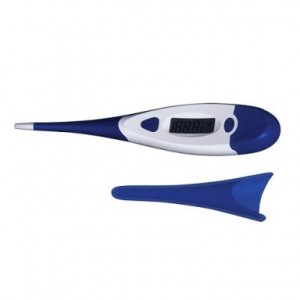Thermometers in your Soay sheep working kit
Will Rogers once said, “The best doctor in the world is the veterinarian. He can’t ask his patients what is the matter–he’s got to just know.” Will Rogers was right, but his vet almost certainly relied on a good thermometer as a substitute for a patient interview.
When we have a listless lamb, one who is not up and nursing robustly pretty quickly after birth, we may need to call a vet, but before we do, we take advantage of the best, most cost-effective diagnostic tool we’ve got — the plastic digital thermometer from a pharmacy or almost any general-purpose store waiting there in the Lamb Kit. The thermometer often can confirm what is wrong even though the lamb and ewe cannot. In the rare circumstance where we have had lambs in trouble, the first thing we do is take its temperature. Odds are the lamb is cold and that almost certainly means he is not nursing at all or not nursing enough to get the bonfire in his tummy going. If we can get him eating, he should come around. And if not, we know the first thing the vet is going to ask is, “what is the lamb’s temperature?” So that is where we start, and here is an example of an inexpensive thermometer, this one readily available.
In our experience, lambs with temperatures between 102.0 and 104.0 Fahrenheit are almost certainly okay; they are eating; they are turning milk into fuel to keep them warm and healthy. Last year we had almost 40 lambs and with two exceptions, their temperatures when we first assessed them were just fine. The two lambs in distress each had temperatures lower than 102 the first time we checked them. In both cases, it was important to get the lambs up and nursing and pronto. Cold lambs do not live very long, period. Remember the blue gloves? We put them on and took the lamb back to the ewe’s udder and did our darnedest to persuade the little guy to eat.We had mixed success. One of the lambs seemed lethargic after the first four hours and his temperature was 101.8 degrees, not alarmingly cold, but low enough to check on him frequently. Although we did not actually see him nurse, when we came back to check on him a couple of hours later we could tell by feeling his belly that he had gotten a little milk. This was confirmed by taking his temperature, which had risen to 102.6 degrees. He only weighed 3 pounds 15 ounces at that time, so we were relieved to see such a wee one fighting hard to make it, and he did. By 11 hours, his temperature had risen another .2 of a degree and from then on he was fine.
The lamb we lost, by contrast, had a temperature of only 100.8 the first time we assessed her shortly after birth, critically low. Although we immediately gave her NutraDrench, tube-fed colostrum-laden milk stripped from the ewe, and put the lamb under a heat lamp, she did not rally, never could get up and nurse on her own, and never showed any signs of being able to survive. Her temperature fell to 100.4, then 99.6, and she died. It was our first face-to-face experience with the concept of “failure to thrive” and a blunt reminder that even with the renowned hardiness of Soay sheep, not every lambing has a happy ending.
A note about thermometers. They do not feel any better in the lamb’s little bum than they do in yours, so give the lamb a break and apply just a smidgen of KY to the tip of the thermometer. You could use Vaseline as well, but KY works better if you make and use one of Steve’s Pretty Good Goo Syringes. Read on.
After the first time Steve wasted the better part of a tube of KY trying to squeeze it out onto the tip of the thermometer, he rigged us a nifty applicator by fitting a 6cc syringe with a 16 guage needle, breaking off the tip of the needle, smoothing the rough edges of the now-blunt end with emery paper, and filling the syringe with KY. With the needle guard back on, we can keep our Goo Syringe around forever. It also comes in handy when we are applying eartags to lambs and adults.
For now …
